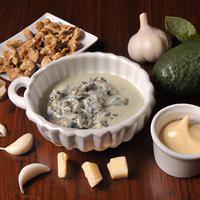
1 serving (50 grams) contains 175 calories, 3.0 grams of protein, 17.5 grams of fat, and 1.5 grams of carbohydrates.

Log this food in SnapCalorie

Nutrition Information
Calories |
829.4 | ||
|---|---|---|---|
% Daily Value* |
|||
| Total Fat | 82.9 g | 106% | |
| Saturated Fat | 47.4 g | 237% | |
| Polyunsaturated Fat | 0 g | ||
| Cholesterol | 213.3 mg | 71% | |
| Sodium | 1421.8 mg | 61% | |
| Total Carbohydrates | 7.1 g | 2% | |
| Dietary Fiber | 0 g | 0% | |
| Sugars | 4.7 g | ||
| protein | 14.2 g | 28% | |
| Vitamin D | 118.5 mcg | 592% | |
| Calcium | 355.5 mg | 27% | |
| Iron | 0.5 mg | 2% | |
| Potassium | 237.0 mg | 5% | |
* Percent Daily Values are based on a 2,000 calorie diet. Your daily values may be higher or lower depending on your calorie needs.
Food Attributes
Source of Calories
About Gorgonzola sauce
Gorgonzola sauce is a rich and creamy condiment originating from Italian cuisine, named after the iconic blue-veined cheese produced in the Lombardy region. The sauce typically combines Gorgonzola cheese with heavy cream, butter, and occasionally flour for thickness, resulting in a smooth texture and a tangy, slightly sharp flavor. Often seasoned with garlic, pepper, or herbs, it’s a favorite accompaniment for pasta, meats, or vegetables. While Gorgonzola sauce is indulgent and packed with bold flavors, it tends to be high in calories, saturated fat, and sodium due to the cheese and cream content. On the positive side, Gorgonzola does offer some protein and calcium, contributing to bone health. However, it’s best enjoyed in moderation, especially for individuals monitoring fat or salt intake. Pairing small portions of the sauce with nutrient-dense foods can help balance its decadent nature within a healthy diet.



